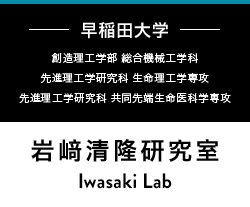病理工学班
脳動脈瘤の病態解明:ヒト病理分析による仮説の導出
「ヒトは血管とともに老いる」は有名な言葉です。(1)加齢とともに血管が老化し、(2)血管老化をもとに血管病が発症する、(3)血管病が進展し血管壁が破綻すれば致死的疾患をきたします。脳動脈瘤は脳動脈の一部がこぶ状になる病気ですが、脳動脈瘤が発症、進展、破綻する原因や機構が分かっていません。その理由としては、血液の流れに加え、血管の物性、構造、変形といった物理的因子が介入した複雑系疾患であるためです。我々は、ヒト病理組織をもとにして組織分析(電子顕微鏡による超微形態像等)と力学分析(流体や構造シミュレーション)を照合して病態原理の解明を進めており、そこから病態原理に対する仮説を導出し、後述する疾患モデル動物等の試験を介して仮説の検証を行っています。より具体的には(1)脳動脈の血管壁はなぜ菲薄化していくのか、(2)菲薄化はどのように抑制・回避されているのかを解明できれば、診断精度の高精度化や新規治療技術の概念提唱へと発展します。.jpg)
.jpg)
図1 ヒト脳動脈瘤の外見(菲薄壁と肥厚壁の共存) 図2 菲薄壁の電顕分析(集団細胞死による空隙の形成・連結)
脳動脈瘤の病態解明:疾患モデル動物による仮説の検証
ラット等の動物を用いて脳動脈瘤モデルを作成する技術は複数あります。例えば、(1)血管結紮による血流環境の改変、(2)分解酵素による血管物性の低下、(3)血管拘束による血管変形の改変などです。異なる技術が複数あるということは、ヒト体内で病態が実際に発症する経路も複数存在することが示唆され、その核心部はどのような因子で構成され、どのような法則により形作られているのかを明らかにすることが重要です。血管壁は長軸・短軸で力学環境(変形、物性等)が全く異なりますが、長軸方向での力学環境の変化および生来のプリストレッチが血管壁の菲薄化の惹起・維持に重要な役割を果たしていることを明らかにしつつあります。この研究により、脳動脈瘤の発症・進展を原理レベルで同定できることが期待されます。 図1 血管結紮による脳動脈瘤モデル。左分枝頂点近位部に発生し、右分枝には発生しない。当該分岐部には生来より内膜肥厚が左分枝近位に存在する。この解剖学的制約が力学的拘束条件となり血管壁が微視的に軸伸長したためと考えられる。実際、右分枝の細胞はもとのまま(周伸長)であるが、左分枝頂点近位部の細胞のみ軸伸長しており、弾性板を侵食しているような形態を示す。
図1 血管結紮による脳動脈瘤モデル。左分枝頂点近位部に発生し、右分枝には発生しない。当該分岐部には生来より内膜肥厚が左分枝近位に存在する。この解剖学的制約が力学的拘束条件となり血管壁が微視的に軸伸長したためと考えられる。実際、右分枝の細胞はもとのまま(周伸長)であるが、左分枝頂点近位部の細胞のみ軸伸長しており、弾性板を侵食しているような形態を示す。 図2 血管拘束による脳動脈瘤モデル。縫合糸を用いて血管を拘束する。それにより血管壁に軸伸長を与える。これを起点として血管壁、特に弾性板がどのように破壊されていくのか、さらに、破壊した弾性板がどのように消失していくのかを明らかにしようとしている。
図2 血管拘束による脳動脈瘤モデル。縫合糸を用いて血管を拘束する。それにより血管壁に軸伸長を与える。これを起点として血管壁、特に弾性板がどのように破壊されていくのか、さらに、破壊した弾性板がどのように消失していくのかを明らかにしようとしている。脳動脈瘤の病態解明:正常モデル動物による仮説の検証
若齢・老齢ラットを用いて血管分岐部の物性、構造、変形を三次元解析し、(1)生来より存在すると仮説立てた血管分岐部の脆弱性の存在を検証すること、および(2)脆弱部に特異的な血管の加齢性変化の存在を明らかにすることを目的としています。血管表面に微粒子を散布し、二台の高速度カメラで粒子をステレオ撮像し、相互相関処理により血管表面の三次元変位を測定します。この情報をもとに血管分岐部の変形を解析したところ、血管分岐部にはある特異な場所があり、その場所でのみ血管壁は生来より軸伸長していることを見出しつつあります。さらに、このような場所における血管の加齢性変化は他部位とは異なり、自然的に菲薄性リモデリングを呈する傾向があることが分かってきました。この研究により、脳動脈瘤の発症・進展を原理レベルで同定できることが期待されます。 図1 血管分岐部の変形。左分枝近位のみ軸伸長する性質があり、血管分岐部における血管形態変化が左右非対称であることによると考えられる。
図1 血管分岐部の変形。左分枝近位のみ軸伸長する性質があり、血管分岐部における血管形態変化が左右非対称であることによると考えられる。 図2 血管分岐部の加齢性変化。左分枝近位部でのみ血管壁は菲薄化し、この場所は図1で示した特異な場所と一致している。血管壁が生来より軸伸長した場所では血管の加齢性変化そのものが異なる様式で進行していることが考えられる。
図2 血管分岐部の加齢性変化。左分枝近位部でのみ血管壁は菲薄化し、この場所は図1で示した特異な場所と一致している。血管壁が生来より軸伸長した場所では血管の加齢性変化そのものが異なる様式で進行していることが考えられる。脳動脈瘤の病態解明:病態原理に基づく新しい診断技術の開発
前述までの研究成果より血管壁ひずみが脳動脈瘤の発症・進展に重要な役割を果たしていることが明らかになってきた。しかし、臨床において血管壁ひずみを利用した脳動脈瘤の診断技術は開発されていません。そこで病態原理の解明に基づく新しい診断技術の開発を目指した研究を開始しています。血管ひずみ計測の臨床応用に向けた要件として(1)ラベルレス、(2)シングルカメラという制約のもと血管壁ひずみを高精度計測できる技術を開発しています。これまでの研究成果において、血管壁ひずみは周囲環境との接触による影響をうけ、接触の程度や有無に応じた補正技術を開発する必要があることが分かってきました。この研究の将来像としてはヒト術中画像への応用があり、それによる仮説の最終的な検証およびそれによる発症・進展リスクの診断技術への波及が期待できます。 図1 血管周囲環境。腹部大動脈の片側は静脈に接触し、対側は脂肪に接触している。このような接触の種類や有無は動脈壁の変形に影響することが分かってきた。
図1 血管周囲環境。腹部大動脈の片側は静脈に接触し、対側は脂肪に接触している。このような接触の種類や有無は動脈壁の変形に影響することが分かってきた。と観測される変形(二次元)の関係.jpg) 図2 実際の変形(三次元)と観測される変形(二次元)の関係。接触の種類や有無におうじて投影誤差が異なり、それを補正する技術が必要であることが分かってきた。
図2 実際の変形(三次元)と観測される変形(二次元)の関係。接触の種類や有無におうじて投影誤差が異なり、それを補正する技術が必要であることが分かってきた。

